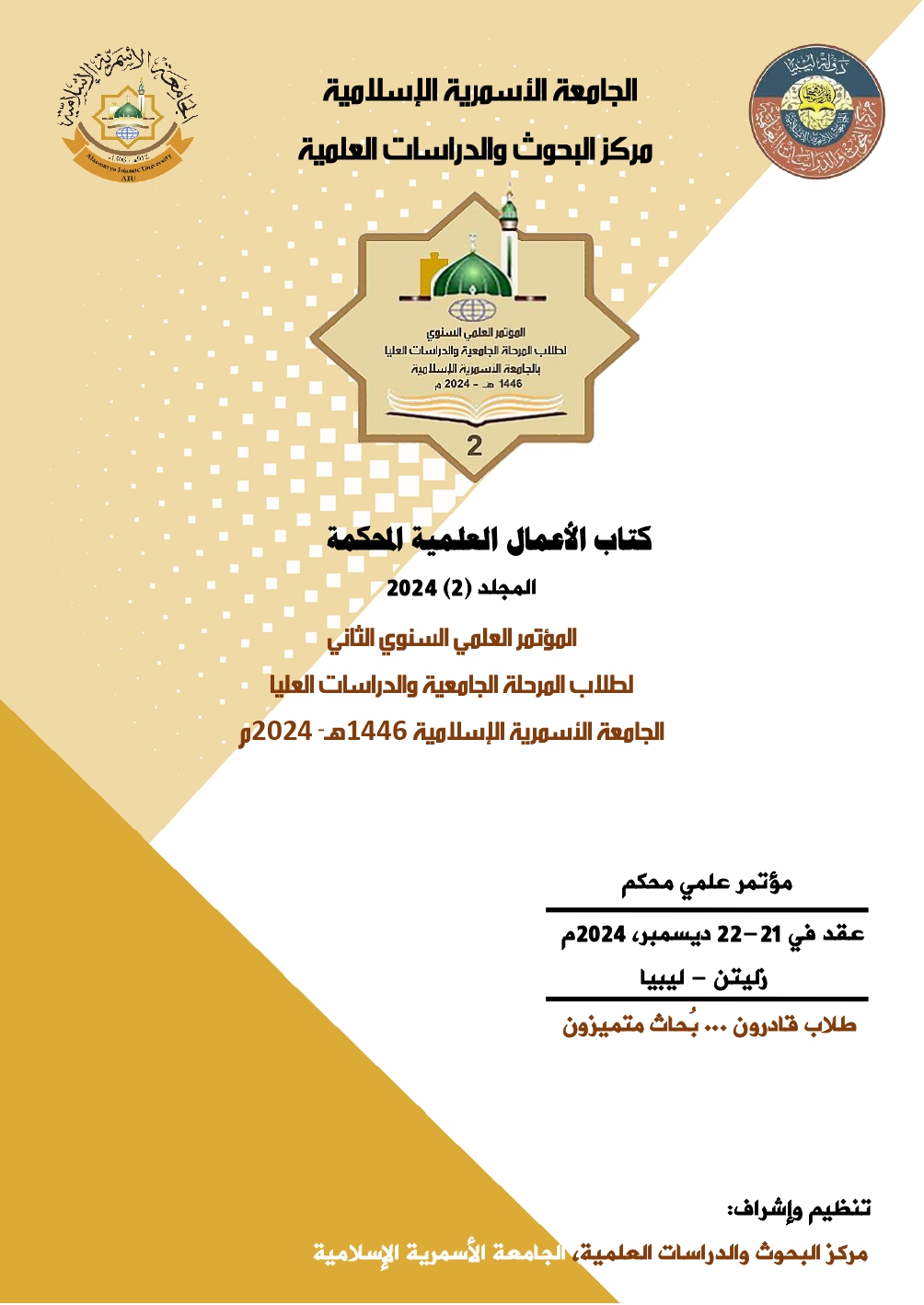Reducing Copper (II) Ions from Aqueous Solutions Using Ficus-Activated Carbon
Keywords:
Adsorption, Water, Copper ions, Activated Carbon, PollutionAbstract
Heavy metals are inherent natural elements in the earth's crust and can be byproducts of industrial activities such as petrochemicals and other manufacturing processes. In this study, the adsorption of heavy metal ions Cu(II) from wastewater using Ficus Activated Carbon (FAC) and the relationship between different adsorption coefficients in the removal of heavy metal ions Cu(II) was examined. The analysis was done by using a spectrophotometer device (ONDA V-10 PLUS). The optimum conditions were a contacting time of 100 minutes at 200 rpm, with 0.4 g of FAC per 35 ml of solution, a particle size of 0.2mm, pH =6, and a temperature of 25 °C. The adsorption capacity for heavy metal ions increased with increasing temperature, pH, contact time, and concentration of heavy metal ions, but decreased with increasing particle size. The adsorption processes are therefore spontaneous thermal desorption processes, and the results demonstrated a good agreement with pseudo-second-order kinetics. The adsorbent prepared in the laboratory (FAC) was placed in a high-temperature 200 oC oven and then activated with hydrogen peroxide acid (H2O2), thus having higher removal rates. In addition, 90% of the heavy metal ions were significantly removed and made the solution the permitted values. The results show that FAC can be used as a green for the adsorption of heavy metals from water.
Downloads
References
Adnan, M., Xiao, B., Ali, M. U., Xiao, P., Zhao, P., Wang, H., & Bibi, S. (2024). Heavy metals pollution from smelting activities: A threat to soil and groundwater. Ecotoxicology and Environmental Safety, 274, 116189. https://doi.org/10.1016/J.ECOENV.2024.116189.
Agarwal, K., Sharma, A., & Talukder, G. (1990). Clastogenic effects of copper sulphate on the bone marrow chromosomes of mice in vivo. Mutation Research, 243(1), 1–6. https://doi.org/10.1016/0165-7992(90)90115-Z.
Aljfairi, K. S., Khlifa Alfeluo, J., & Alnabi, M. A. (2019). Removal of Copper (II) Ions from Aqueous Solution Using Pine Activated Carbon. Libyan Journal of Ecological and Environmental Sciences and Technology, 1(1), 49-56. www.srcest.org.ly/jou.
Alshuiref, A. A., Ibrahim, H. G., Ben Mahmoud, M. M., & Maraie, A. A. (2017). Treatment of wastewater contaminated with Cu (II) by adsorption onto acacia activated carbon. Journal of Marine Sciences and Environmental Technologies (JMSET), 3(2), 25-36.
Alshuiref, A. A., Maraie, A. A., Bseibsu, A. J., & Ibrahim, H. G. (2020). Equilibrium, Kinetic, and Thermodynamic Study of the Adsorption of Cu (II) From Aqueous Solution Using Activated Carbon Derived from Acacia. Journal of Marine Sciences and Environmental Technologies (JMSET), 6(2), 29-48.
Çelebi, H., Gök, G., & Gök, O. (2020). Adsorption capability of brewed tea waste in waters containing toxic lead(II), cadmium (II), nickel (II), and zinc(II) heavy metal ions. Scientific Reports 2020 10:1, 10(1), 1–12. https://doi.org/10.1038/s41598-020-74553-4
Chakraborty, R., Asthana, A., Singh, A. K., Jain, B., & Susan, A. B. H. (2022). Adsorption of heavy metal ions by various low-cost adsorbents: a review. International Journal of Environmental Analytical Chemistry, 102(2), 342–379. https://doi.org/10.1080/03067319.2020.1722811
Charlier, D., Legendre, B., & Ricci, O. (2024). Water and energy deprivation: Addressing the problem of essential utility services poverty in Mayotte. Energy Policy, 195, 114364. https://doi.org/10.1016/J.ENPOL.2024.114364
Elgarahy, A. M., Elwakeel, K. Z., Mohammad, S. H., & Elshoubaky, G. A. (2021). A critical review of biosorption of dyes, heavy metals and metalloids from wastewater as an efficient and green process. Cleaner Engineering and Technology, 4, 100209.
Ibrahim, H. G., Maraie, A. A., & Elhebshi, A. M. (2016). Removal of Cu(II) Ions from Aqueous Solutions by Adsorption On to Activated Carbon Derived from Olive Waste Cakes. Journal of Engineering Research and Applications Www.Ijera.Com, 6, 31–37. www.ijera.com
Jaishankar, M., Tseten, T., Anbalagan, N., Mathew, B. B., & Beeregowda, K. N. (2014). Toxicity, mechanism and health effects of some heavy metals. Interdisciplinary Toxicology, 7(2), 60. https://doi.org/10.2478/INTOX-2014-0009
Purkait, M. K., Haldar, D., & Debnath, B. (2023). Removal of heavy metals from aqueous medium using tea waste derived adsorbent materials. Technological Advancements in Product Valorization of Tea Waste, 121–149. https://doi.org/10.1016/B978-0-443-19239-5.00006-1
Saleh, T. A., Mustaqeem, M., & Khaled, M. (2022). Water treatment technologies in removing heavy metal ions from wastewater: A review. Environmental Nanotechnology, Monitoring and Management, 17, 100617. https://doi.org/10.1016/J.ENMM.2021.100617.
Sarma, P., & Kumar, R. (2015). Batch and Continuous Removal of Copper and Lead from Aqueous Solution using Cheaply Available Agricultural Waste Materials. In: International Journal of Environmental Research. https://www.researchgate.net/publication/276959888
Singh, B. J., Chakraborty, A., & Sehgal, R. (2023). A systematic review of industrial wastewater management: Evaluating challenges and enablers. Journal of Environmental Management, 348, 119230. https://doi.org/10.1016/J.JENVMAN.2023.119230.
Zamora-Ledezma, C., Negrete-Bolagay, D., Figueroa, F., Zamora-Ledezma, E., Ni, M., Alexis, F., & Guerrero, V. H. (2021). Heavy metal water pollution: A fresh look about hazards, novel and conventional remediation methods. Environmental Technology and Innovation, 22. https://doi.org/10.1016/j.eti.2021.101504
Downloads
Published
Conference Proceedings Volume
Section
License
Copyright (c) 2024 محمد معمر أبوجمرة، خالد علي اعبيد، صالح الهمالي الناكوع

This work is licensed under a Creative Commons Attribution-NonCommercial-NoDerivatives 4.0 International License.





